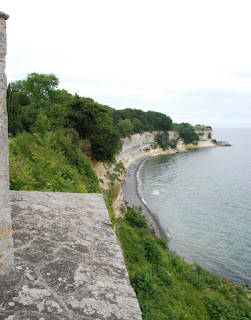We
have already visited two of Harald Bluetooth’s ring fortresses at Aggersborg
and Fyrkat and now we are off to visit another ring, which might be another
Harald Bluetooth fort or it might not. There had been thoughts by
archaeologists that there should be another ring fort in Eastern Zealand but
none had been found. In 2013 a young archaeologist, Nanna Holm, from Aarhus
university, studied aerial photographs of the area near Koge and found a round
feature that she thought could be a fort. LIDAR showed the feature more clearly
and the university called on the assistance of an archaeologist from York
(ironically, as York was a Viking town) to carry out a detailed geophysical survey.
This clearly indicated that the feature was very significant and likely to be a
ring fort. Digging started in 2014 and will continue until 2018 and has already
shown that there was a ditch and an 11m wide bank with a very high palisade
(see photo) making a circle with a 123m diameter. It is estimated that it would
have taken 90 mature oak trees, at least 200 years old, to make the palisade.
From the analysis of the soils in the bank, it is believed that the whole
structure was erected in one season, possibly within a couple of months. This
is a huge task and shows the power and authority wielded by the person who
ordered its construction. This may well have been Harald Bluetooth, the dates
so far seem to fit but there are differences between this fort and the others
that he built. Test pits made in the centre on the fort have not found evidence
of the roads and buildings found in the other forts.
We
joined a god number of interested Danes for guided tour and although the tour
was primarily in Danish, our guide made a point of explaining everything to us
in English as we moved on to the next point. When we reached the excavation, we
were introduced to Nanna and her knowledge and great enthusiasm was clear to
see. She made a point of talking to us in English and answered our questions.
She said how excited she was about two areas of excavation that they were doing
this season. Next week they are going to excavate a section of the centre of
the fort and then they will know whether the roads and houses exist on this
site. They are also going to excavate a large area outside the fort where,
Nanna said, they may find a settlement, a cemetery or absolutely nothing! I
will definitely be checking the blog on their website (www.vikingeborgen.dk) to follow what is
happening. Next year they will excavate the last gate in the east where they
hope to find waterlogged wood that will more accurately date the construction
of the fort.
There
are not a huge amount of finds from the site but some are very interesting.
They found a toolbox of iron objects dated from 950 – 1050 and a piece of nondescript
Stamford pottery that told an interesting tale. Stamford pottery comes from
England but in this piece, the clay was Danish and the glaze was English. Nanna
explained that after 1066 the Vikings in Britain went into quick decline and
many headed back to Denmark, bringing skilled tradesmen with them who then
continued their work in Denmark.
Wi-Fi
was provided on site so that visitors could download an app on their
smartphones. This allowed more information to be obtained on certain subjects
and on the finds. It also has virtual reality where 3-D videos can be viewed
using special glasses that attach to the phone. I haven’t tried that yet but
other aspects of the app and the large number of information boards are
excellent. It was interesting that on the app, boards and website, the four
main archaeologists are presented almost as heroes – the Cult of the Archaeologists!
This I suspect appeals to the young but Nanna told us that there is huge
interest in the project from the Danish media with lots of coverage every time
that a new discovery is made.
Just
south of Koge is Stevns Klint – a UNESO listed area of cliffs, so we headed off
to take a look. They were very pretty and, for the Danes, are quite a novelty but
living in South West England, we have much more impressive cliffs and, of
course, the UNESCO listed Jurassic Coast.
We
returned to the campsite and walked into Koge, clutching some lovely ice creams
from the kiosk across the road. Koge is a pleasant town with some nice historic
buildings but it didn’t keep us for very long which was good as, just as we got
back to the van, it started to rain.
Photos:
From the viewing tower at the reception area there was a very good view over
the site with the latest excavation area (at the north gate) clearly visible, covered
with a marquee; The Cult of the Archaeologists – one of the many information
boards; Nanna explaining the current excavations; Jane providing scale to
demonstrate the height of palisade – it easy to image how the fort would have
dominated the area; The conserved toolbox with its three sections; The cliffs
of Stevns Klint; Part of Koge’s harbour – we wondered whether Danish Agro was
code for ‘Viking’ with a Viking warship moored in front.







No comments:
Post a Comment